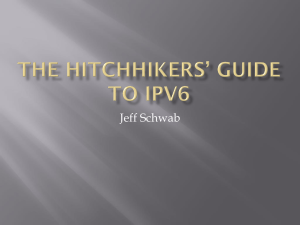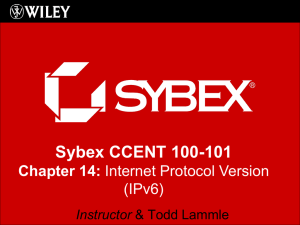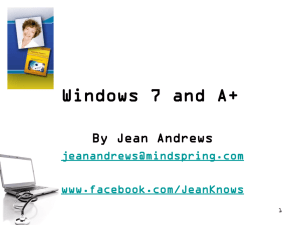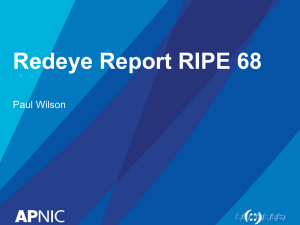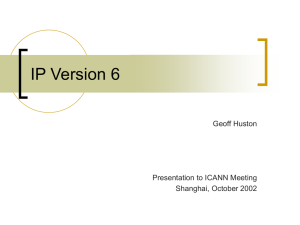IP version 6
advertisement
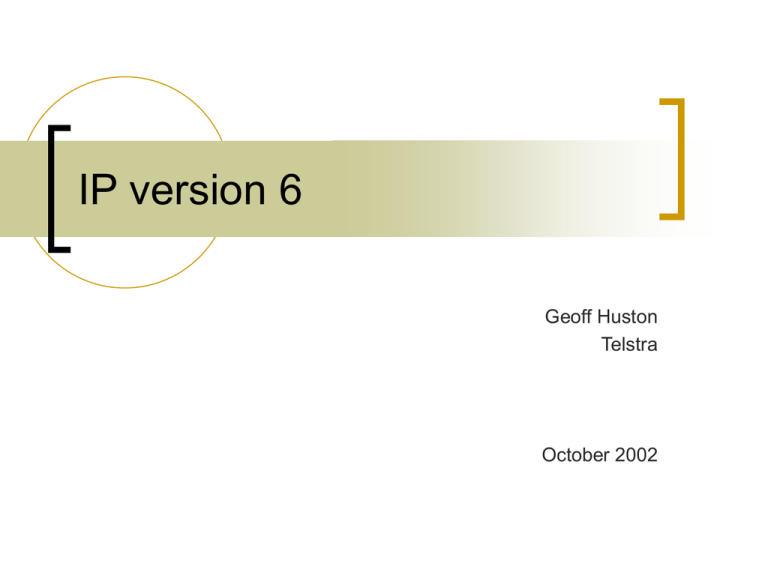
IP version 6 Geoff Huston Telstra October 2002 IP Version 6 Background What is IPv6 Why IPv6 And a few IPv6 myths as well Background 1991 - 1993 January 1991 – IAB Architecture Review If we assume that the Internet Architecture will continue in use indefinitely then we need additional [address] flexibility Two problems: November 1991 – IETF ROAD Group Growth in the inter-AS routing table Consumption of IP address space (noteably the Class B block) IETF Group set up to examine the consumption of address space and the exponential growth in inter-domain routing entries and propose scalable solutions September 1993 – RFC1519 Classless Inter-Domain Routing ROAD outcome Routing refinements intended to alleviate pressure on B space Short term alleviation of address consumption through improved potential for address utilization IETF adoption of IPv6 June 1992 – IAB decides to adopt OSI CLNS as the successor protocol to IPv4 July 1992 – IETF plenary decides otherwise 1992 – 1994 – IETF undertakes an evaluation of a collection of potential next gen IP protocols TUBA, SIP, PIP, SIPP, …. 1994 – IETF design team defines IPv6 protocol IPv6 is… IP with: Larger address fields (128 bits) Yes, that’s a VERY big number! Smaller number of header fields Altered support for header extensions Addition of a flow label header field IPv6 What has not changed Almost everything! IPv6 is a connectionless datagram delivery service using end-to-end address identifiers and end-to-end signalling with TCP and UDP transport services. So is IPv4. IETF IPv6 Specifications There are 90 RFCs that describe aspects of IPv6 Including: RFC2460 RFC2373 Internet Protocol, Version 6 (IPv6) Specification [December 1998] IP Version 6 Addressing Architecture [July 1998] RFC3177 IAB/IESG Recommendations on IPv6 Address [September 2001] IETF IPv6 Working Group Request For Comments: An Architecture for IPv6 Unicast Address Allocation (RFC 1887) Internet Protocol, Version 6 (IPv6) Specification (RFC 1883) Internet Control Message Protocol (ICMPv6) for the Internet Protocol Version 6 (IPv6) (RFC 1885) DNS Extensions to support IP version 6 (RFC 1886) IP Version 6 Addressing Architecture (RFC 1884) IPv6 Testing Address Allocation (RFC 1897) Path MTU Discovery for IP version 6 (RFC 1981) OSI NSAPs and IPv6 (RFC 1888) A Method for the Transmission of IPv6 Packets over Ethernet Networks (RFC 1972) Neighbor Discovery for IP Version 6 (IPv6) (RFC 1970) Transmission of IPv6 Packets Over FDDI (RFC 2019) IP Version 6 over PPP (RFC 2023) An IPv6 Provider-Based Unicast Address Format (RFC 2073) Basic Socket Interface Extensions for IPv6 (RFC 2133) TCP and UDP over IPv6 Jumbograms (RFC 2147) Advanced Sockets API for IPv6 (RFC 2292) IP Version 6 Addressing Architecture (RFC 2373) An IPv6 Aggregatable Global Unicast Address Format (RFC 2374) IPv6 Multicast Address Assignments (RFC 2375) Neighbor Discovery for IP Version 6 (IPv6) (RFC 2461) IPv6 Stateless Address Autoconfiguration Internet Control Message Protocol (ICMPv6) for the Internet Protocol Version 6 (IPv6) Specification (RFC 2463) Transmission of IPv6 Packets over Ethernet Networks (RFC 2464) Internet Protocol, Version 6 (IPv6) Specification (RFC 2460) IP Version 6 Management Information Base for the Transmission Control Protocol (RFC 2452) IP Version 6 Management Information Base for the User Datagram Protocol (RFC 2454) IETF IPv6 Working Group Request For Comments: (cont) Management Information Base for IP Version 6: Textual Conventions and General Group (RFC 2465) Management Information Base for IP Version 6: ICMPv6 Group (RFC 2466) Proposed TLA and NLA Assignment Rules (RFC 2450) Transmission of IPv6 Packets over FDDI Networks (RFC 2467) Transmission of IPv6 Packets over Token Ring Networks (RFC 2470) IPv6 Testing Address Allocation (RFC 2471) IP Version 6 over PPP (RFC 2472) Generic Packet Tunneling in IPv6 Specification (RFC 2473) Transmission of IPv6 Packets over ARCnet Networks (RFC 2497) IP Header Compression (RFC 2507) Reserved IPv6 Subnet Anycast Addresses (RFC 2526) Transmission of IPv6 over IPv4 Domains without Explicit Tunnels (RFC 2529) Basic Socket Interface Extensions for IPv6 (RFC 2553) IPv6 Jumbograms (RFC 2675) Multicast Listener Discovery (MLD) for IPv6 (RFC 2710) IPv6 Router Alert Option (RFC 2711) Format for Literal IPv6 Addresses in URL's (RFC 2732) DNS Extensions to Support IPv6 Address Aggregation and Renumbering (RFC 2874) Router Renumbering for IPv6 (RFC 2894) Initial IPv6 Sub-TLA ID Assignments (RFC 2928) Privacy Extensions for Stateless Address Autoconfiguration in IPv6 (RFC 3041) IP Version 6 Management Information Base for the Multicast Listener Discovery Protocol (RFC 3019) Extensions to IPv6 Neighbor Discovery for Inverse Discovery Specification (RFC 3122) IPv6 multihoming support at site exit routers (RFC 3178) Transmission of IPv6 Packets over IEEE 1394 Networks (RFC 3146) Unicast-Prefix-based IPv6 Multicast Addresses (RFC 3306) Recommendations for IPv6 in 3GPP Standards (RFC 3314) IETF IPv6 Working Group Internet-Drafts: IPv6 Node Information Queries A Flexible Method for Managing the Assignment of Bites of an IPv6 Address Block Advanced Sockets API for IPv6 Internet Control Message Protocol (ICMPv6)for the Internet Protocol Version 6 (IPv6) Specification Default Address Selection for IPv6 IP Version 6 Addressing Architecture IPv6 Scoped Address Architecture Basic Socket Interface Extensions for IPv6 Well known site local unicast addresses for DNS resolver Default Router Preferences, More-Specific Routes and Load Sharing An analysis of IPv6 anycast Privacy Extensions for Stateless Address Autoconfiguration in IPv6 IPv6 Host to Router Load Sharing IPv6 Flow Label Specification IPv6 for Some Second and Third Generation Cellular Hosts Link Scoped IPv6 Multicast Addresses IPv6 Node Requirements IP Forwarding Table MIB Management Information Base for the Transmission Control Protocol (TCP) Management Information Base for the Internet Protocol (IP) Management Information Base for the User Datagram Protocol (UDP) Multi-link Subnet Support in IPv6 Generic Packet Tunneling in IPv6 Specification Scoped Address Extensions to the IPv6 Basic Socket API IETF NGTrans Working Group Request For Comments: Transition Mechanisms for IPv6 Hosts and Routers (RFC 1933) Routing Aspects of IPv6 Transition (RFC 2185) 6Bone Routing Practice (RFC 2546) Stateless IP/ICMP Translation Algorithm (SIIT) (RFC 2765) Network Address Translation - Protocol Translation (NAT-PT] (RFC 2766) Dual Stack Hosts using the Bump-In-the-Stack Technique (BIS) (RFC 2767) 6Bone Backbone Routing Guidelines (RFC 2772) Transition Mechanisms for IPv6 Hosts and Routers (RFC 2893) 6BONE pTLA and pNLA Formats (pTLA) (RFC 2921) IPv6 Tunnel Broker (RFC 3053) Connection of IPv6 Domains via IPv4 Clouds (RFC 3056) A SOCKS-based IPv6/IPv4 Gateway Mechanism (RFC 3089) An anycast prefix for 6to4 relay routers (RFC 3068) An IPv6-to-IPv4 transport relay translator (RFC 3142) Internet-Drafts: An overview of the Introduction of IPv6 in the Internet Dual Stack Transition Mechanism (DSTM) Survey of IPv4 Addresses in Currently Deployed IETF Standards Connecting IPv6 Domains across IPv4 Clouds with BGP Support for Multicast over 6to4 Networks Intra-Site Automatic Tunnel Addressing Protocol (ISATAP) SMTP operational experience in mixed IPv4/IPv6 environements An IPv6/IPv4 Multicast Translator based on IGMP/MLD Proxying (mtp) Moving in a Dual Stack Internet Dual Stack Hosts using 'Bump-in-the-API' (BIA) NGtrans IPv6 DNS operational requirements and roadmap Teredo: Tunneling IPv6 over UDP through NATs Interaction of transition mechanisms MIME TYPE definition for tunnels Dual Stack Transition Mechanism (DSTM) Overview ISATAP Transition Scenario for Enterprise/Managed Networks Unmanaged Networks Transition Scope Transition Mechanisms for IPv6 Hosts and Routers IPv6 Strengths Larger Addresses Allows billions of devices to be interconnected IPv6 Strengths Larger Addresses mean no forced Network Address Translators Eliminate NAT architectures as a means of address scaling Allow coherent end-to-end packet delivery Improve the potential for use of end-to-end security tools for encryption and authentication Allow for widespread deployment peer-to-peer applications SIP, IMM, … IPv6 Strengths No NATS (cont) Regain fundamental leverage of IP as a network architecture Simple interior service requirement Service environment defined as end-to-end application This is a VERY GOOD THING Complex network architectures scale very poorly! IPv6 – Transition and Coexistence V6 will not take over all data networking requirements in a working future timeframe i.e. V4 is not disappearing anytime soon About the most likely scenario is a dual stack world for some years to come Dual stack worlds present many complex issues in terms of referential integrity of identity, reachability, gateway functionality, and application functionality These are current activities Public Network IPv6 Status Increasing level of experimentation and trials within the ISP provider sector BUT still no overwhelming impetus to immediately deploy V6 services in many markets Widespread “wait and see” attitude IPv6 Myths IPv6 is “more secure” than V4 IPv6 is no more or less secure than V4 Both IPv6 and IPv4 offer stronger potential security than “IP with header mangler” architectures simply because the original IP source and destination address header fields can be included in the packet authentication space IPv6 Myths Only IPv6 supports mobility Both V4 and V6 support mobility equally well (or equally poorly!) The problem is the overloaded semantic of an IP address which duals as identity and network location This is the subject of ongoing efforts IPv6 Myths IPv6 offers “bundled” QoS Nothing has changed. The TOS field in V4 is the TOS field in V6 The Flow-ID field has no practical application in large scale networks QoS deployment issues are neither helped nor hindered by V4 or V6 Packet-based and stream-based QoS signalling is one type of approach to resource management of a shared network. It is not obvious that this particular form of signaling is the right approach to resource management in large scale public IP networks, let alone whether V6 is the only way to achieve this. IPv6 Myths Only V6 offers plug and play autoconfiguration V4 networks these days are DHCP-equipped There is an increasing issue over the desire for “plug and play simplicity”, which invariably leads to solutions of stateless auto-configuration, and a desire to associate a constant “identity association” with a device. It was anticipated that the low order 64 bits of the V6 address space would be an identity field. There are, however, complications here…. IPv6 Myths IPv6 allows rapid renumbering Not Really Define “rapid”: 10-3 seconds? No! 106 seconds ? Possibly This is no different from V4 + DHCP IPv6 Myths IPv6 supports multi-homing and provider choice Not really See rapid renumbering Multihoming is a tough technical topic V6 makes multi-homing no harder and no easier IPv6 Myths IPv6 solves the Routing issues Routing is a cross-product of topology, policy and dynamic behaviour V6 does not make routing easier or more scaleable IPv6 Myths All IPv4 space has been exhausted 25% of the IPv4 space is routed 50% of the IPv4 space has been allocated to LIRs and End Users Widespread use of NATs in corporate deployments and public deployments reduces pressure on address consumption IPv6 vs IPv4 There is no compelling “feature” or aspect of V6 that does not have a functional counterpart in V4. Any industry adoption of V6 cannot based on superior functionality of V6 over V4 as a protocol platform The fundamental (and only) difference is the larger address fields used on V6 But this single difference is probably enough to propel V6 adoption in a ‘smart device’ world Thank You

